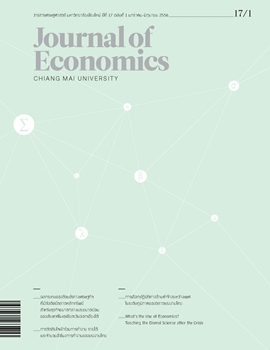การเลือกปฏิบัติทางด้านค่าจ้างระหว่างเพศในระดับภูมิภาคของตลาดแรงงานไทย
Keywords:
ความแตกต่างของค่าจ้างระหว่างเพศ, การเลือกปฎิบัติทางเพศ, ช่องว่างค่าจ้าง, ระหว่างเพศ, gender wage differential, gender discrimination, gender wage gapAbstract
การศึกษาครั้งนี้มีวัตถุประสงค์เพื่อศึกษาการเลือกปฏิบัติทางเพศด้านค่าจ้างในแต่ละภูมิภาคของตลาดแรงงานไทย โดยแยกศึกษาเป็น 3 ส่วน คือ ศึกษาปัจจัยที่ส่งผลกระทบต่อค่าจ้าง ศึกษาสาเหตุความแตกต่างของค่าจ้างระหว่างแรงงานชายและหญิง และศึกษาสาเหตุการเปลี่ยนแปลงช่องว่างของความแตกต่างระหว่างค่าจ้างของระหว่างแรงงานชายและหญิง โดยใช้ข้อมูลทุติยภูมิ จากการสำรวจภาวะการทำงานของประชากรทั่วราชอาณาจักร ของสำนักงานสถิติแห่งชาติในไตรมาสที่ 3 ของ พ.ศ. 2545 และ พ.ศ. 2554 ซึ่งใช้วิธีการประมาณสองขั้นตอนตามวิธีของ Heckman (1979) ในการประมาณสมการค่าจ้างของแรงงานชายและหญิง โดยอาศัยแนวคิดของ Oaxaca และ Ransom (1994) ในการศึกษาสาเหตุความ แตกต่างของค่าจ้างระหว่างแรงงานชายและหญิง และใช้แบบจำลองจากของ Dolton (1996) ศึกษาสาเหตุการเปลี่ยนแปลงช่องว่างของความแตกต่างระหว่างค่าจ้างของแรงงานชายและหญิง ผลการศึกษาพบว่า ตัวแปรที่มีนัยสำคัญทางสถิติต่อสมการค่าจ้างในแต่ละภูมิภาค คือ ประสบการณ์การทำงาน ระดับการศึกษา สถานภาพโสดในแรงงานชาย อาชีพ อุตสาหกรรม การทำงานในภาคเอกชน และอัตราส่วนความน่าจะเป็นของความหนาแน่นต่อการกระจายของ การแจกแจงแบบสะสม (แลมด้า) โดยที่ในภาพรวมทั้งประเทศของ พ.ศ. 2545 และ พ.ศ. 2554 มีตัวแปรพื้นที่อยู่อาศัยหรือทำงานของแรงงาน ซึ่งสาเหตุความแตกต่างของค่าจ้างระหว่าง แรงงานชายและหญิงในแต่ละภูมิภาคและภาพรวมทั้งประเทศได้ผลเหมือนกัน คือ มาจากการเลือกปฏิบัติทางเพศเป็นหลักเช่นเดียวกับช่องว่างของความแตกต่างระหว่างค่าจ้างของแรงงานชายและหญิงที่เกิดขึ้นนั้น เกิดจากการเปลี่ยนแปลงของการเลือกปฏิบัติทางเพศที่ทำให้ช่องว่างของความแตกต่างระหว่างค่าจ้างของแรงงานชายและหญิงเพิ่มขึ้น ซึ่งเป็นส่วนที่มีผลต่อช่องว่างของความแตกต่างระหว่างค่าจ้างของแรงงานชายและหญิงมากที่สุด
This study was conducted to gain an insight into the issue of gender wage Discrimination in various regions of Thai labor market. It consisted of three sections namely the study on the determinants of wage rates, the investigation on the causes of wage differential between genders in each region and for the whole nation during 2002—2011, and the examination on the causes of change in the gender wage gap in the Thai labor market during 2002—2011. It was based on the National Statistical Office’s nationwide employment survey data reported in the third quarter of 2002 and 2011. The estimation of wage equations with respect to male and female labors was undertaken after the two–step procedure of Heckman (1979) to correct for bias sample selection. To understand the causes of wage gap between genders following the work of Oaxaca and Ransom (1994). The model advanced by Dolton (1996) was applied for examining the causes of change in gender wage gap. The findings revealed the determinants at statistically significant level of wage differences between male and female labors in each region to include work experience, education, single marital status of male labors, occupation, industry, employment in private sector, and Lambda (Inverse Mill’s ratio) while the determinant of differential wage offers to male and female labors at the aggregate level in 2002 and 2011 was found to be the residence or workplace factor only. On the determinants of gender wage gap at regional and national levels, it was found that the essential factor of discrimination that rendered the lower wage offers to women. Meanwhile, it was apparent that the change increase in gender wage gap was due solely to the change in the attitude towards gender discrimination which the most effect of the change in gender wage gap.
Downloads
Issue
Section
License
All opinions and contents in the CMJE are the responsibility of the author(s). Chiang Mai University Journal of Economics reserves the copyright for all published materials. Papers may not be reproduced in any form without the written permission from Chiang Mai University Journal of Economics.
ข้อคิดเห็นที่ปรากฏและแสดงในเนื้อหาบทความต่างๆในวารสารเศรษฐศาสตร์มหาวิทยาลัยเชียงใหม่ ถือเป็นความเห็นและความรับผิดชอบโดยตรงของผู้เขียนบทความนั้นๆ มิใช่เป็นความเห็นและความรับผิดชอบใดๆของวารสารเศรษฐศาสตร์ มหาวิทยาลัยเชียงใหม่
บทความ เนื้อหา และข้อมูล ฯลฯ ในวารสารเศรษฐศาสตร์มหาวิทยาลัยเชียงใหม่ ถือเป็นลิขสิทธิ์เฉพาะของคณะเศรษฐศาสตร์มหาวิทยาลัยเชียงใหม่ หากบุคคลหรือหน่วยงานใดต้องการนำทั้งหมดหรือส่วนหนึ่งส่วนใดไปเผยแพร่ต่อหรือเพื่อกระทำการใดๆ จะต้องได้รับอนุญาตเป็นลายลักษณ์อักษร จากวารสารเศรษฐศาสตร์ มหาวิทยาลัยเชียงใหม่






